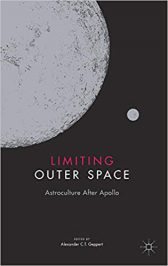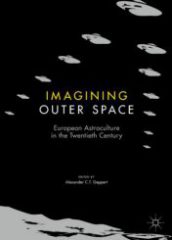Introducing the second volume of the European view on space programs and the sociocultural effects of current and future space travel and planet colonization plans, Limiting Outer Space continues the Palgrave Studies in the History of Science and Technology series.
 The title is strongly linked to Vol. 1 Imagining Outer Space: European Astroculture in the Twentieth Century from 2012 (just reprinted in a paperback edition) which presents a truly multidisciplinary and highly informative outlook on the Space Age from the European perspective. Volume 1 deals with – to use editor Geppert’s words – “European Astrofuturism”; it was set out to “contour a new field of historical inquiry – ‘astroculture’ ….”
The title is strongly linked to Vol. 1 Imagining Outer Space: European Astroculture in the Twentieth Century from 2012 (just reprinted in a paperback edition) which presents a truly multidisciplinary and highly informative outlook on the Space Age from the European perspective. Volume 1 deals with – to use editor Geppert’s words – “European Astrofuturism”; it was set out to “contour a new field of historical inquiry – ‘astroculture’ ….”
Fifteen brilliant essays discussed numerous aspects of space travel and the effects on contemporary and future day societies, mankind in general, economics, science, the humanities, medical research and naturally also on literature. After all, in part, it was science fiction like the writings of Asimov, Wells, Verne and others that first contemplated interplanetary travel and the countless aspects for mankind in its course. From solving future aspects of anything from farming, terra forming, intercultural communications, legal and scientific problems to possible contact with extraterrestrial life forms. At least seven essays dealt with topics also familiar to aspects of popular culture research: science fiction stories, space travel in comics, UFO encounters, science fictions movies such as 2001, and aliens from outer space.
The essays of that title, in a way, lead to further aspects of the general idea of space travel and astroculture.
The second volume in the series, Limiting Outer Space: Astroculture After Apollo, now debates the peculiar period of the 1970s, a crisis-ridden decade when all the earlier excitement and national attention for various space programs suddenly waned and even died completely, possibly because imaginaries of manned space flight had become real. This “post-Apollo period” (the American Apollo program from 1961-1972 accomplished six moon landings) saw worldwide public disillusionment, not just on an intellectual level. Then, seemingly utopian thought and a positive outlook on the future of mankind experienced limitations as after the moon landing in 1969 very “earthly” problems such as the Vietnam war or the oil-crisis came to the fore.
Looking back, it seems that once Armstrong set foot on the moon, all excitement for space travel died quickly and a certain worldwide “space fatigue” set in.
 With the same multidisciplinary approach to the causes and possible explanations of this development some 40 years ago, editor Geppert successfully – again – pays attention to the highly complicated fabric that held together, or rather changed the Weltanschauung of the day, political thought and altogether laid the foundations of the decades to come.
With the same multidisciplinary approach to the causes and possible explanations of this development some 40 years ago, editor Geppert successfully – again – pays attention to the highly complicated fabric that held together, or rather changed the Weltanschauung of the day, political thought and altogether laid the foundations of the decades to come.
Compared to Vol. 1, the emphasis in thirteen fresh essays is more on issues of globalization and the shifting meaning of borders, architecture, ideology, legal aspects (of space travel and colonization), planetary consciousness, and finally the new focus on very real (and already reached) frontiers, instead of the “final frontier” in outer space.
Of special interest here are sections on the direct effects on popular culture of the 1970s, as another chapter on Kubrik’s 2001, LEGO’s Legoland Space, imaginary space colonies and stations in science fiction, space architecture in film sets and an analysis of a number of dystopian science fiction movies. Alien, Dark Star, Silent Running and others suggest that space exploration may not hold the answer to future problems of mankind.
However, all the new satellites in orbit by the 1970s, allowed a so far virtually unknown experience of planet Earth, correspondingly the focus of many people was self-centered, to explore oneself and one’s individualist behavior, needs and character, instead of outer space. Ironically, the communication satellites only existed because of the space programs.
Even if the texts here are subsumed under the heading of astroculture, they additionally give a vivid picture of a decade always represented as a somewhat uninteresting period, a time when nothing really important happened. Looking back at the decade now, it becomes very obvious that actually a lot happened and that the “long 1970s” were a time of huge transitions on almost all levels of society, politics, science and economy.
After all, the basic conclusions of the compiled essays clearly also challenge the still popular theory/idea of the epoch as plainly dominated by US-USSR Cold War rivalry.
Both volumes are very recommended for scholars, not just of architecture, film studies, anthropology, sociology or environmental studies, as they connect European astroculture and its perspective on space flight (back then largely done by Soviet and US astronauts). Moreover, fans of science fiction will be delighted by the many themes already familiar to them.
Review by Dr. A. Ebert © 2018
Alexander C. T. Geppert, ed. Imagining Outer Space: European Astroculture in the Twentieth Century (Palgrave Studies in the History of Science and Technology, Vol. 1), Palgrave, 2018 (2nd ed.), 444 p.
Alexander C. T. Geppert, ed. Limiting Outer Space: Astroculture After Apollo (Palgrave Studies in the History of Science and Technology, Vol. 2), Palgrave, 2018, 376 p.
